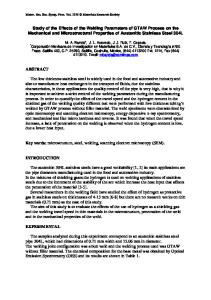Effect of the Number of Welding Repairs with GTAW on the Mechanical Behavior of AA7020 Aluminum Alloy Welded Joints
- PDF / 1,002,890 Bytes
- 8 Pages / 593.972 x 792 pts Page_size
- 117 Downloads / 407 Views
RODUCTION
ALUMINUM alloys with high tensile strength of 7xxx series are commonly used as structural components in the aeronautic, aerospace, and transport sectors where the specific strength (strength-to-weight ratio) is a critical factor.[1,2] Although AA7020-T6 is a structural aluminum alloy, it is not as common as AA7075, AA7150, or AA7475, but it is widely used in superstructures of transportation vehicles such as trains and busses since it is more readily weldable. However, the weldability of these alloys is moderate as they have three major problems: porosity,[3] softening of the heataffected zone (HAZ),[3,4] and hot cracking. Hot cracking during solidification occurs due to the presence of liquid films of low melting point located at the grain boundaries of the material. These may occur on the Weld SANTIAGO MAYA-JOHNSON, Ph.D. Student, is with the Brazilian Nanotechnology National Laboratory (LNNano), Rua Giuseppe Ma´ximo Scolfaro 10.000, Campinas 13083-970 Brazil, and also with the Welding Group, Facultad Nacional de Minas, National University of Colombia, Carrera 80 # 65 – 223, Medellı´ n, Colombia, 050041. Contact e-mails: [email protected]; santiago.johnson@ lnnano.cnpem.br JUAN FELIPE SANTA, Assistant Professor, is with the Grupo de Investigacio´n Materiales Avanzados y Energı´ a (MATyER), Instituto Tecnolo´gico Metropolitano Medellı´ n, Carrera 31 # 54 – 10, Medellı´ n, Colombia, 050013 and also with the Welding Group, Facultad Nacional de Minas, National University of Colombia, Carrera 80 # 65 – 223, Medellı´ n, Colombia, 050041. OSCAR L. MEJI´A, SANTIAGO ARISTIZA´BAL, SEBASTIAN OSPINA, PAULA ANDREA CORTE´S, M. Eng. Students, and JORGE ENRIQUE GIRALDO, Associate Professor, are with the Welding Group, Facultad Nacional de Minas, National University of Colombia, Carrera 80 # 65 – 223, Medellı´ n, Colombia, 050041. Manuscript submitted November 7, 2014. METALLURGICAL AND MATERIALS TRANSACTIONS B
Metal Fusion Zone—WMFZ—(called solidification cracking) or the weld metal heat-affected zone—WMHAZ—also known as partially molten zone, (called liquefaction cracking).[5] Additionally, the welds of the Al-Zn-Mg alloys reported in some cases a low resistance to stress corrosion cracking (SCC), even in some mild environments where water vapor in the air is sufficient to cause the failure.[6–9] Therefore, Al-Zn-Mg alloys have been less widespread than other aluminum alloys because of a possible failure due to SCC in the welding region.[10] For this reason, Al-Zn-Mg alloys are used in applications where the specific strength is more important than corrosion resistance. When these alloys are welded (typically using filler metals of the 5xxx series), the strength of the WMFZ is reduced and they become sensitive to failure by SCC. One important question for engineers working with welding of those alloys would be what would happen to an aluminum structure if it was repaired during service? Accordingly, this article describes the effect of the number of repairs by welding, up to six repairs, in an AA7020-T6 aluminum alloy joint welde
Data Loading...











